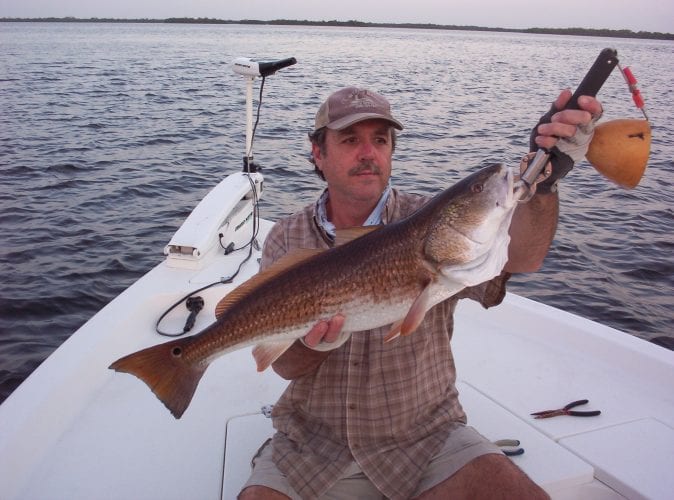October is always a good month to spot redfish

Photo provided Capt. George Tunison with a big red.
For the salty angler who enjoys the sport of quietly hunting shallow water gamefish, nothing beats the sudden sighting of a big fish, nose down, tail happily wagging in the air as it scours the bottom for its breakfast. The only thing better is seeing a whole school of glistening waving tails in the early morning sunshine.
The “Grey Ghost” or permit; the silver bullet of the Keys, the bonefish; or the bulldozer of the flats, our redfish, all exhibit this tails out of water feeding behavior in the shallows, which is guaranteed to raise the blood pressure of any flats angler.
Although red drum or redfish are a year-round catch-and-release target here in Southwest Florida, October is considered to be the primo month for shallow water redfish schooling activity. Depending on the weather, this fishing will continue through late November before many of these fish go offshore to live in the Gulf and Atlantic, never to return to skinny water.
Our offshore boating regulars occasionally see these massive acre-sized schools rise to the surface of the Gulf turning the water copper orange.
Red drum range far and wide, with the biggest of the big gathering around the Carolinas, while millions of others spend their lives Cajun style around New Orleans. I received pictures this week of a recent Delaware Bay flounder trip that turned into a complete surprise, multiple quality redfish outing, as a school of big reds moved through the bay.
The most efficient method of hunting and catching tailing flats fish is by the use of a push-poled shallow water skiff. Trolling motors need more water to operate in and are often way too noisy telegraphing your approach in the super shallow water.
The angler up on the poling platform, riser or cooler providing near silent propulsion with the height advantage making distant fish movements much easier to spot then passing this info to the unseeing on deck angler below is the best approach.
Having a long rod allows long distant casts to these feeding fish without spooking them with your presence. Big fish are already on high alert in thin water as they are often easy pickings for feathered predators from above. In the boat, dropping a can, slamming a lid, pressure waves from too much hull rocking or Cousin Tim and his size 14 work boots stomping around the skiff, usually puts these fish off the feed and heading for a different ZIP code.
Silently work your way into casting distance while determining the path the single fish or school is taking. Cast and drop your lure, fly or bait out in front of the fish then draw it across the fish’s line of travel usually resulting in an instant solid strike. Too close and you bomb the fish – game over.
Learning to feather the line at the reel spool with your fingertips at the end of the cast slows down the lures entry into the water lessening the noise or fish spooking factor.
Finding fish is one thing. Finding feeding fish is another. The good thing about spotting tailing fish is that not only have you found the fish but you obviously can see they’re in feeding mode.
Unless you make mistakes and alert them, schooled and feeding reds fall easily for a well presented live or plastic shrimp appearing in front of them. A gold spoon or gold spoon fly is a sure winner as well as a top water plug
It’s quite obvious that the upcoming election results have serious potential to negatively and permanently impact the future of fishing, hunting, boating and 2nd Amendment rights in America.
Carefully weigh the past voting record, past and current position statements of each candidate and the groups that support them before making a wise decision at the polls in the most important election of our lifetimes.
Freedoms lost are often lost forever..
Capt. George Tunison is a Cape Coral resident fishing guide. Contact him at 239-282-9434 or captgeorget3@aol.com.

